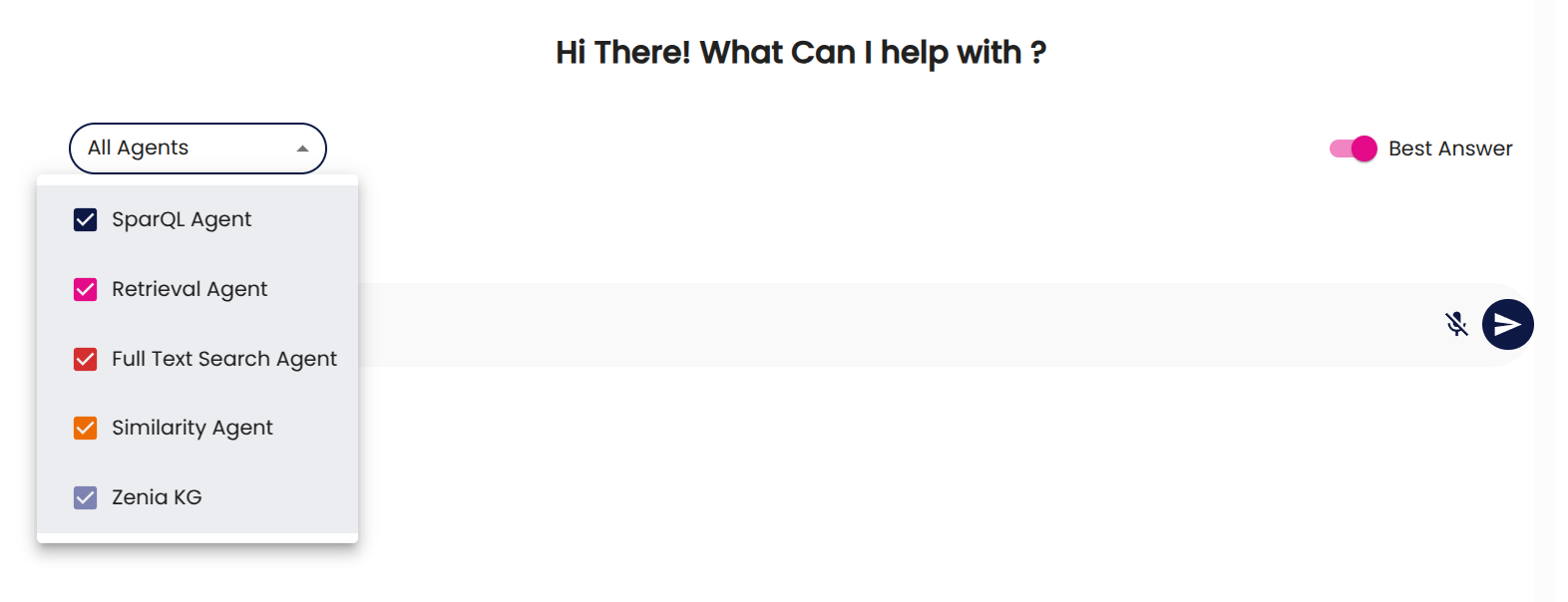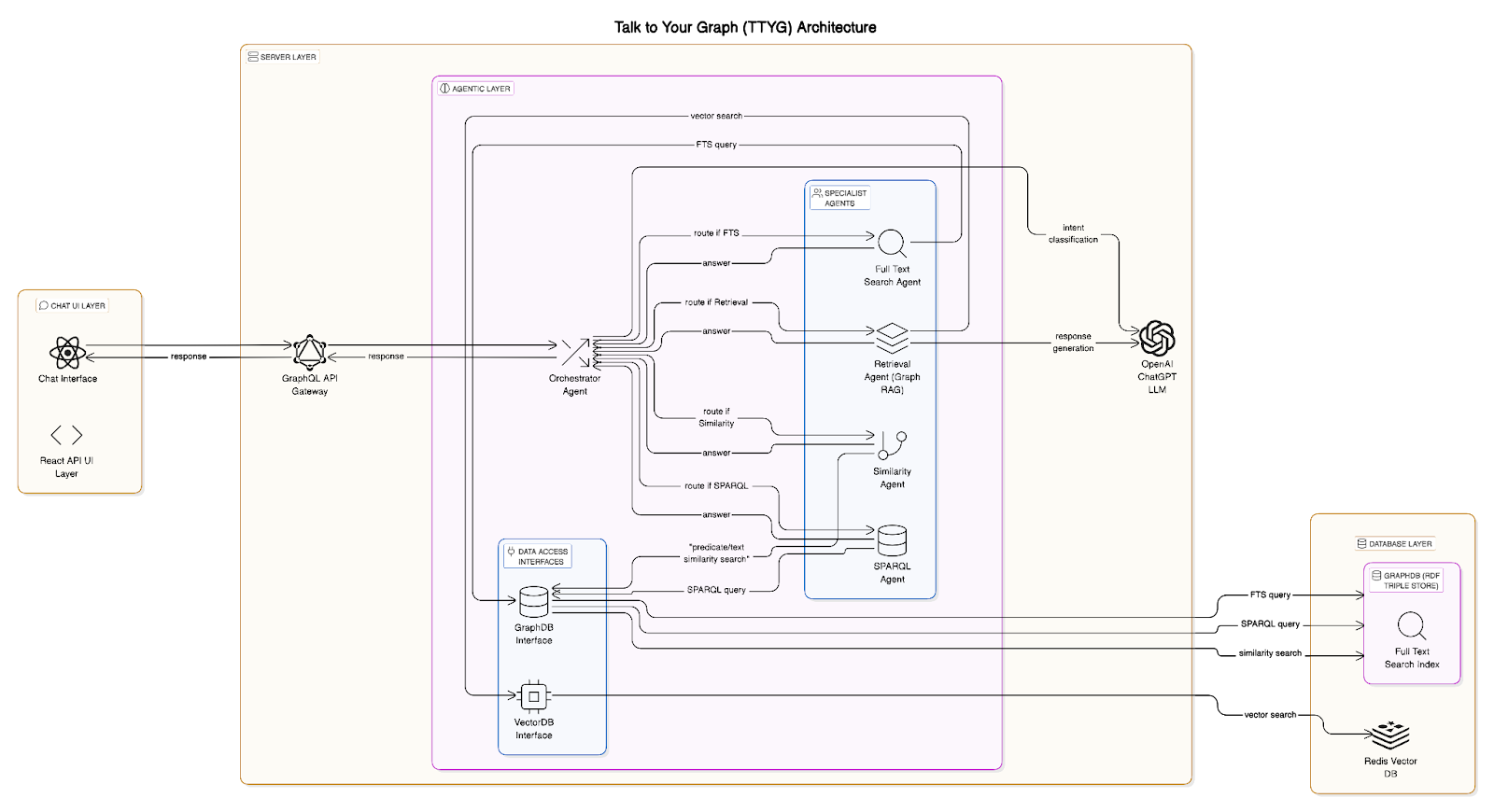This article shares insights from Zenia Graph’s collaborative experience with GraphDB and its Talk to Your Graph interface, provided by Graphwise.
Today’s enterprises are overflowing with data spanning customers, sales, products, and job applicants. Transforming this information into timely, actionable insights remains a significant hurdle. Business users want answers, not dashboards. They want to ask questions like they would to colleagues and get back clear, accurate insights.
However, there are still major challenges:
- Answers are often buried in dashboards or scattered across disconnected systems
- Retrieving information from reports or databases is often slow and unintuitive
- Teams spend hours each week chasing down the same basic information
At Zenia Graph, in collaboration with Graphwise, we set out to solve this. As early participants in the “Quadro Liftoff” program, we tested Talk to Your Graph 2.0 (TTYG) — a cutting-edge graph and conversational AI technology. In this blog, we share how we used TTYG to enhance our Salesforce and HR Recruiting solutions, making it easier for business teams to interact with complex data without relying on technical expertise.
What Is Talk to Your Graph (TTYG), and Why Does It Matter?
Imagine being able to ask a question like:
“Who are our competitors with more than $30 billion in revenue?”
“Which candidates are most similar to the one who applied to Apple?”
Then, instantly receive reliable answers powered by a unified view of data from Salesforce, LinkedIn, Excel spreadsheets, and even PDF documents.

That’s the power of TTYG. It serves as an intelligent interface that connects the dots between different types of data and turns them into clear, easy-to-understand answers. Even better, you can ask your questions with no need for technical jargon, SQLs, or dashboards.
The magic behind TTYG is that it leverages intelligent agents to search different parts of your data: some retrieve structured metrics, others scan documents, and others identify patterns. These agents collaborate to return a single, confident answer. Every response includes traceability, so users not only get an answer but also understand how the system arrived at their conclusion.
A key feature of TTYG is its Agentic Graph RAG architecture, which uses a team of specialized AI agents, not just a single chatbot, to retrieve and reason over data. Powered by a knowledge graph, these agents are orchestrated to handle structured queries, unstructured search, and semantic similarity tasks with precision. Unlike most AI tools, TTYG also offers built-in explainability, showing how answers are generated and which agents contributed, ensuring trust and transparency for enterprise use.
Upgrading Salesforce Insights with TTYG & AI Agents
Our Salesforce Accelerator equips business development teams with a competitive edge — identifying opportunities, trends, and key stakeholders faster.
By embedding TTYG, we added a conversational intelligence layer that enables users to:
- Query Growth Trends: “What is the 3-year growth rate of Apple?”
- Run Comparisons: “Who has higher revenue, Apple or Microsoft?”
- Discover Relationships: “Who can introduce me to the CTO of Zenia Graph via Metacube?”
Previously, these insights required manual checking of multiple internal and external documents and tools as well as expert intervention. Now, they’re available in seconds, grounded in real-time data, and accessible via simple questions.
Business Impact:
- Significant reduction in time spent researching executive summaries
- Sales teams saved hours per week with natural language Q&A features
- Improved win rates through faster, smarter competitive research
Strategic Hiring with the HR Recruiting Accelerator
In recruitment, speed and relevance are critical. Hiring teams often sift through hundreds of resumes and candidate profiles, tracking application statuses across disparate systems while trying to assess skills and align candidates with changing role requirements.
By integrating TTYG into our HR Recruiting Accelerator, we enabled:
- Job Matching: “Find similar jobs to Lead Data Engineer.”
- Candidate Scoring: “Is Candidate-56 a good fit for this job?”
- Resume Insights: “What are the top skills of Candidate-75?”
Business Impact:
- Significant reduction in manual resume screening
- Improved recruiter productivity
- Enhanced AI-powered matching led to better candidate-job fit
With TTYG, hiring becomes more strategic, data-driven, and human-centric, helping organizations reduce turnover and attract the right talent faster.
Why This Is a Game-Changer for Business Teams
Most AI tools today are either too generic to be useful or too technical to be accessible. TTYG, combined with our Zenia Graph Accelerators, strikes the balance.
Key Differentiators:
- Understands your business language
- Connects directly to existing data sources — no migrations required
- Explains where the answer came from, improving trust and auditability
- Streamlines daily workflows, from sales research to talent sourcing
Built on top of a knowledge graph, TTYG understands context and relationships between entities — companies, roles, deals, products, or people — providing far more accurate and relevant answers instantly.
Technical Deep Dive: Architecture and Lessons Learned
The power and flexibility of TTYG stem from its enterprise-ready, multi-layered architecture and an intuitive user interaction model that redefines how business users engage with complex data systems. Here’s a look under the hood, based on the system we implemented:

Architectural Overview:
- Frontend: React-based chat UI enables user-friendly natural language interaction.
- API Layer: GraphQL API Gateway handles efficient, structured data exchange between the frontend and the backend.
- Agentic Core: Built with Python and LangGraph, this layer orchestrates queries using OpenAI’s ChatGPT LLM.
- Orchestrator (Supervisor) Agent: Receives the initial query and delegates tasks to appropriate specialized agents.
- Specialized Agents:
- Similarity Agent: Handles semantic matching tasks.
- Retrieval Agent: Uses Graph RAG with vector search on GraphDB-derived chunks via Redis.
- FTS Agent: Performs keyword-based full-text search on GraphDB.
- SPARQL Agent: Executes structured queries and aggregations on the RDF knowledge graph.
- Data Layer
- Agents access data through abstracted interfaces to –
- Redis Vector DB for fast vector search
- GraphDB for querying RDF triples, full-text indexes, and entity relationships
- Agents access data through abstracted interfaces to –
Key architectural insights:
- Modular agent design ensures components like FTS or SPARQL agents can evolve independently; simplifying updates, testing, and scalability.
- The hybrid reasoning approach combines:
- Symbolic methods (GraphDB, SPARQL) for precise logic-based queries
- Sub-symbolic methods (LLMs, Redis vector search) for flexibility and language understanding
- LangGraph proved effective in managing orchestration, state tracking, and task routing between agents.
- Clean abstraction layers between data sources and agent logic improve long-term maintainability and integration.
- Traceable logs and transparent queries ensure enterprise-grade explainability, which is critical for trust, governance, and debugging.
User Interaction Highlights:
- Conversational Interface: Users interact with a React-based chat UI designed for natural language input. Unlike rigid dashboards, this interface supports freeform business questions like “Which candidates are most similar to the one hired at Apple?” or “Show me all third parties with access to over 50 files containing PII.” Making data access intuitive for all user levels.
- Contextual Memory: Through LangGraph and Redis, TTYG preserves query context across sessions. This enables multi-turn conversations, follow-up questions, and refinement of results — critical for analytical workflows.
- Transparent Responses: TTYG can show users the specific methods and queries (like the SPARQL queries) used to generate each response. Every response includes a “Why this answer?” toggle, which reveals the underlying agents, query types (e.g., SPARQL, vector search), and source graphs used, improving trust and auditability.
- Flexible Output Formats: Users can request tabular data, charts, or links to filtered dashboards depending on the use case. This allows seamless handoff from conversation to action.
- Role-Aware Personalization: TTYG adapts responses based on user role (e.g., recruiter, compliance officer) and entitlements, offering personalized views without retraining the model.
- Multiple Agent System: TTYG utilizes a multi-agent system including Full Text Search (like a Google search engine), SPARQL Query Search (to get precise data from the Graph DB), Semantic Similarity Search (for every concept/data in the graph), and Graph RAG (Question & Answer from the graph). This provides users with varied ways to access and understand the data depending on their needs, whether it’s a general keyword search, a specific graph-based question requiring a detailed SPARQL query, or a more nuanced similarity-based inquiry.
Turning Data into Decisions: What TTYG Means for Your Business
By integrating Quadro-powered TTYG agents into our solutions, Zenia Graph has empowered organizations to talk directly to their data. Instead of searching across tools or waiting on reports, users get fast, accurate answers from intelligent AI agents that understand business context.
Why this Matters:
- TTYG makes complex data accessible through easy, natural conversations.
- Speeds up decision-making by giving teams instant access to insights.
- In our pilot, recruiters tripled their productivity, and BI queries ran significantly faster.
In short: TTYG doesn’t just make data smarter — it makes your organization more agile, informed, and competitive.
TTYG also directly addresses key enterprise IT needs:
- Integration, Not Migration: TTYG connects to existing systems like GraphDB, eliminating the need for large-scale data migrations.
- Transparency and Governance: Its agentic design reveals underlying queries (SPARQL, FTS), enabling explainability, validation, and AI oversight.
- Leverage Existing Infrastructure: It enhances the value of current investments in GraphDB and Redis by integrating seamlessly with existing data and models.
- Scalable and Maintainable: A modular, microservices approach allows independent scaling and simplifies updates.
- Understands Business Language: Using LLMs within a structured agent framework, TTYG turns natural language into precise, explainable insights.
In essence, TTYG bridges the gap between complex backend data systems, applications, and the business users who need insights from them, providing a solution that is both intelligent and trustworthy.
What’s Next for Zenia Graph and Graphwise
We’re continuing to evolve our enterprise solutions powered by TTYG and knowledge graphs. Upcoming innovations include:
- Highly intuitive user interface with contextual smart suggestions
- Supporting voice input and accessibility enhancements
- Expanding into new use cases — legal, finance, and compliance
- Developing explainability dashboards for enterprise AI governance
Meanwhile, Graphwise is actively enhancing the core Quadro platform with new features, expanded connectors, and faster inference performance based on partner feedback. This collaboration is key to pushing the boundaries of Agentic & AI Agents and Knowledge Graphs.
Together, we’re driving a new era of enterprise AI, where business users can interact with data as easily as having a conversation
If you want to see how this could work with your own data, you can request a demo of the Salesforce or HR Accelerators.


 onerror="this.style.display='none'" />
onerror="this.style.display='none'" />